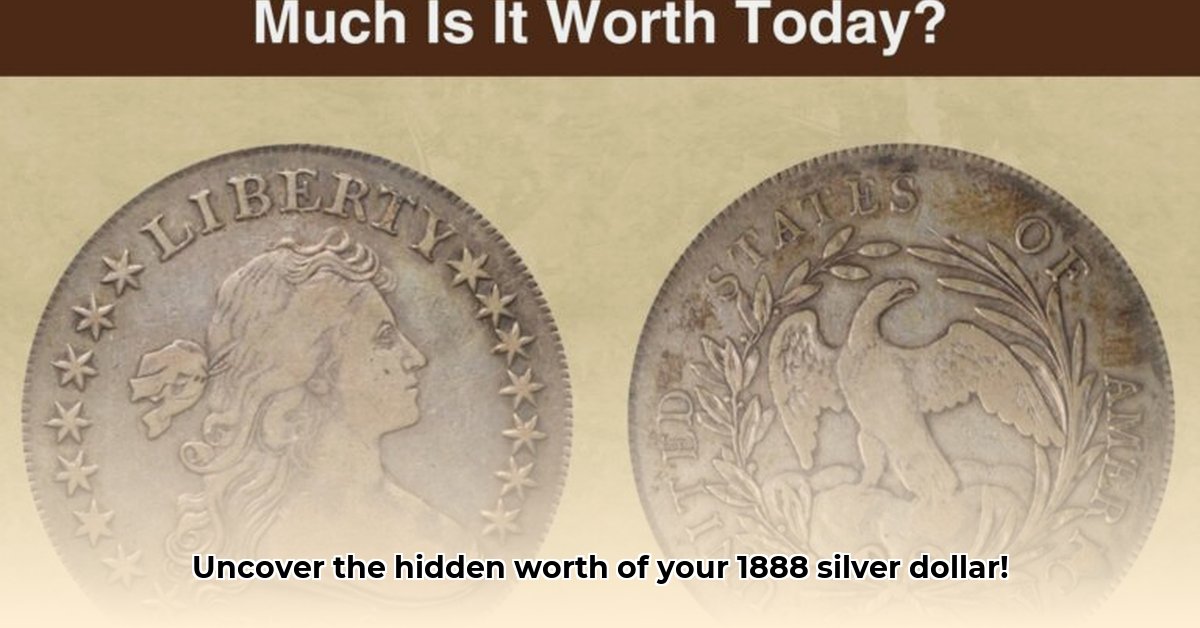
Understanding the Value of Your 1888 Morgan Silver Dollar
An 1888 Morgan silver dollar is more than just a coin; it's a piece of American history. Its value, however, isn't solely determined by its silver content. Condition, mint mark, and market forces significantly influence its worth. This guide will equip you with the knowledge to assess its value, whether you're a collector, dealer, or investor. For more on valuable historical currency, check out this guide on rare dollar bills.
Grading and Condition: The Cornerstone of Value
The condition of your 1888 Morgan dollar is the most crucial factor determining its value. Professional numismatists use the Sheldon grading scale, ranging from Poor (P) to Mint State (MS). Each grade reflects the coin's wear and tear. A Mint State (MS) coin is practically perfect, while a coin graded "Good" shows significant wear. The higher the grade, the more valuable the coin. While a subjective process, careful examination reveals key indicators.
- Mint State (MS): Near-perfect condition, exhibiting minimal to no wear.
- About Uncirculated (AU): Shows minimal wear, with only light handling marks.
- Extremely Fine (EF): Slight wear is visible, but most details remain sharp.
- Very Fine (VF): Moderate wear is apparent, with some detail loss.
- Fine (F): Significant wear is present, with many details obscured.
- Good (G): Heavy wear, with most details significantly worn.
(Images of each grade should be included here)
What to look for when assessing condition yourself:
- Surface wear: Examine the surfaces for scratches, abrasions, and environmental damage.
- Strike: Observe how sharply the design details are defined. A weak strike will lower the grade.
- Toning: Note any discoloration caused by environmental factors. While some toning can enhance a coin's value, excessive or uneven toning lowers it.
Have you ever wondered why grading can be subjective? Even experienced graders may slightly disagree on a coin's grade due to the nuances of wear and tear.
Mint Marks and Rarity: Location, Location, Location
Each 1888 Morgan dollar bears a mint mark—a small letter indicating its origin: 'P' (Philadelphia), 'O' (New Orleans), or 'S' (San Francisco). This seemingly insignificant detail significantly impacts a coin's value. The 1888-S, with a mintage of approximately 657,000, is considerably rarer than the 1888-P and 1888-O (millions minted for each). Rarity translates directly into higher value.
Market Value and Pricing: A Dynamic Landscape
Precisely pricing an 1888 Morgan dollar is challenging due to constant market fluctuations. The table below offers approximate value ranges based on grade and mint mark. Remember, these are estimates; actual values depend on market conditions and specific coin characteristics. A professional appraisal is crucial for accurate valuation.
| Mint Mark | Grade | Approximate Value Range (USD) |
|---|---|---|
| P | MS65 | $250 - $750 |
| P | Good | $25 - $50 |
| O | MS65 | $300 - $800 |
| O | Good | $30 - $60 |
| S | MS65 | $700 - $2000+ |
| S | Good | $100 - $200 |
Is it surprising that these values vary so widely? The coin market is dynamic, influenced by supply, demand, and collector preferences. It's more than the silver content; it's the historical significance that adds to the value.
Silver Melt Value: A Baseline for Price
While collector demand drives the premium, the intrinsic value of the silver content provides a minimum worth. An 1888 Morgan dollar contains approximately 0.7734 troy ounces of silver. Calculating its melt value using the current silver spot price gives a baseline value, below which it's generally unwise to sell. Do you know how to calculate the melt value? It's a simple calculation using the current silver spot price.
Investment Considerations: Strategies for Different Stakeholders
The approach to 1888 Morgan dollars varies greatly depending on your role in the market:
Collectors: Focus on acquiring high-grade, well-preserved coins. Build a collection strategically, seeking out key dates and mint marks. Reputable dealers and professional grading services are essential.
Dealers: Accurate pricing, strong marketing, and a keen understanding of market trends are vital for success. Build a trustworthy reputation for authenticity and expertise.
Investors: Diversification is key to mitigating risk. Track silver market trends and consider other investment options to balance your portfolio. The numismatic market is volatile; careful planning is essential.
Authenticity and Risk Mitigation: Avoiding Counterfeits
Counterfeit 1888 Morgan dollars exist. Protecting your investment requires vigilance:
Professional Grading: Utilize reputable services like PCGS or NGC to verify authenticity and grade. This added verification provides substantial peace of mind.
Careful Examination: Before purchasing, closely inspect the coin for inconsistencies in markings, weight, and metal composition.
Reputable Dealers: Source coins only from established and trustworthy dealers with demonstrable expertise. Building trust and rapport with respected dealers helps prevent mishaps.
Conclusion: Your Journey into Numismatic Discovery
The value of your 1888 Morgan silver dollar is a complex interplay of condition, mint mark, and market forces. Understanding these factors is crucial for accurate valuation. Whether you're a seasoned collector or a curious owner, diligent research and responsible purchasing practices will maximize your investment.